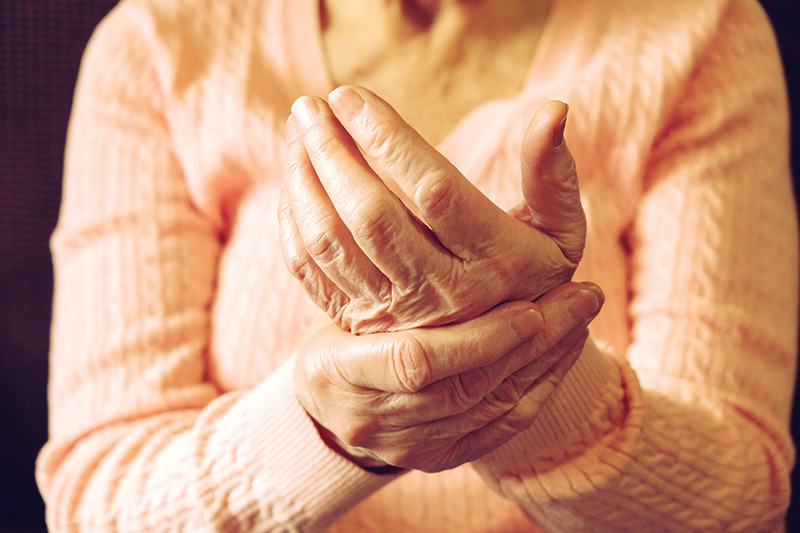Rheumatoid Arthritis – Causes, Symptoms and Treatments

Author: Leslie Chudomelka, Pharmacy Intern
What is RA?
Rheumatoid arthritis (RA) is an alteration of the immune system resulting from an unknown cause that leads to the body mistakenly attacking itself. When immune cells attack these tissues of the body, it causes inflammation and swelling to occur that can be very painful. Chronic inflammation, can damage the cartilage covering the ends of bones, and to tendons holding the bones in place, leading to erosion and deformities.
RA can impact many different areas of the body, such as the skin, eyes, lungs, heart and blood vessels, but is most often localized to the joints. The joints most commonly affected include the hands, feet, wrists, elbows, knees and ankles, making mobility difficult for those with this disorder.
It is imperative to diagnose early and treat aggressively as the damage caused by this disease is irreversible.
What causes RA?
There are many theories that have been developed in regards to what causes RA to occur in the body. The strongest correlations that exist include family history, smoking, environmental exposures (asbestos or silica) and obesity.
Who gets RA?
RA affects about 70 in 100,000 people. Women are more likely to develop rheumatoid arthritis than men. About 5% of the population of women over the age of 55 are affected. Prevalence increases with age.
Signs and Symptoms
The first symptoms of RA are often tender, warm, and swollen joints due to the inflammatory response. As a result of the swelling, the space between bones becomes smaller, making it harder and more painful to move. The joints may also seem stiff, especially in the morning and after long periods of rest. The stiffness usually lasts longer than 30 minutes, and it may even be hours before it subsides.
Reddening of the skin around the affected joints might eventually follow these symptoms. Joint symptoms of RA will always present equally on both sides of the body, as opposed to osteoarthritis, which affects one side worse than the other. Physical activity may ease the stiffness and associated tenderness.
Additional symptoms of RA sometimes include fatigue, loss of appetite and a low-grade fever.
Diagnosis
There is no single test to diagnose RA. Blood tests can look for proteins in the blood that suggest high levels of inflammation, and for antibodies that are attacking your healthy tissue, called rheumatoid factor (RF). This antibody correlates to an 80% chance of developing RA or another inflammatory disease. It is found in a handful of patients with other autoimmune disorders, but when found in people with rheumatoid arthritis, high levels of RF might indicate a likelihood to develop more aggressive symptoms.
RF can also sometimes be present in individuals without diseases. A complete knowledge of patient history and current symptoms is important when determining the significance of a positive rheumatoid factor result. Additionally, use of x-rays and ultrasound images of joints can be helpful in confirming a diagnosis of RA. They can detect joint damage and help determine if RA is the cause of erosion. Talk to your doctor about a referral to a rheumatologist, who can better understand the development and progression of your joint issues.
Medications
While there is no cure for RA, there are many drugs that can alleviate symptoms and help the disease go into a state of remission. Classes of drugs used to treat rheumatoid arthritis include non-steroidal anti-inflammatory drugs (NSAIDS), corticosteroids and disease modifying anti-rheumatic drugs (DMARDs). Each has its own purpose in the course of the disease.
NSAIDS are anti-inflammatory drugs that are used short-term to relieve pain and stiffness caused by inflammation. They do not prevent the deterioration of bone and cartilage caused by the immune system, but they will help alleviate swelling that occurs during flare-ups. The most commonly used NSAIDs are ibuprofen (Advil) and naproxen (Aleve), which are available over-the-counter. Other stronger alternatives are available with prescriptions – celecoxib (Celebrex) or diclofenac (Voltaren) – but come with a greater risk of stomach problems.
Corticosteroids work similarly to NSAIDs, but provide additional benefits. These medications reduce inflammation and slow joint damage, and work by suppressing formation of the antibodies that are attacking the body’s healthy tissue. Prednisone, methylprednisolone and dexamethasone are some examples that are often prescribed for RA. While they may help prevent the damaging effects of rheumatoid arthritis, they have some serious effects that can develop after prolonged use, including high blood pressure, increased blood sugar, weight gain, mood swings and insomnia. Because of this, they are only used for a short period, as a “bridge” to the disease-modifying drugs (DMARDs).
DMARDs save joints and other tissues from permanent damage caused by the immune system by interrupting the production of immune cells. This leads to a reduction in inflammation and pain that accompanies the attack of tissues. Some commonly used DMARDs include methotrexate, sulfasalazine, leflunomide and hydroxychloroquine, and can take up to 6 months to take effect. A subset of non-traditional DMARDs targets specific pathways that cause inflammation. They may be more fast-acting than traditional DMARDs, but are only available as injection. Humira, Enbrel and Orencia are common examples. Both traditional and non-traditional DMARDs increase risk of infection, so patients using this class of drugs for RA need to be cautious of their surroundings.
Physical therapy
Your doctor may recommend exercises that minimize the strain on affected joints while improving overall body strength, or he may send you to a physical or occupational therapist who specializes in how to keep your joints flexible. Physical therapists may offer assistive devices that avoid placing unneeded stress on your joints, and they can suggest new ways to do daily tasks.
Exercise
RA increases risk of heart attack due to the immune system’s attack on blood vessels and the heart muscle. Regular exercise, such as walking or yoga, wards off heart disease by strengthening the heart, improving circulation and lowering blood pressure. It also helps build stronger muscles that can better support your joints. If you are having trouble managing the symptoms or RA or the side effects of the drugs, be sure to talk to your doctor or your Hy-Vee Pharmacy Solutions pharmacist.
